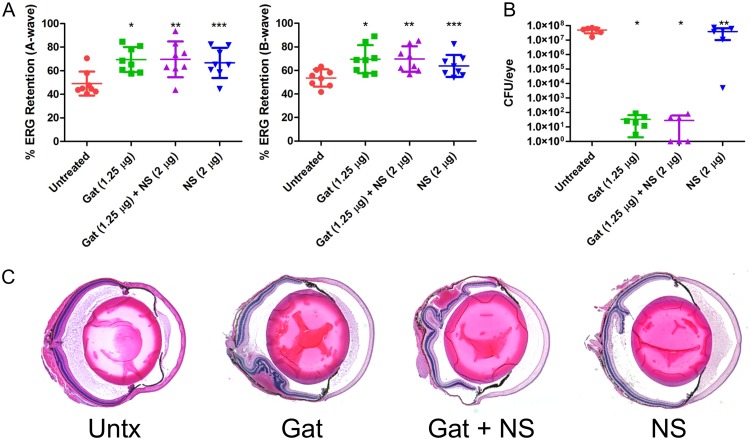FIG 5.
Human nanosponges increased retinal function retention and preserved retinal architecture but did not influence growth following S. pneumoniae infection in a murine model of endophthalmitis. Right eyes of mice were infected with 100 CFU of S. pneumoniae. At 6 h postinfection, S. pneumoniae-infected right eyes were intravitreally injected with 0.5 μl PBS only (untreated control), 0.5 μl PBS containing 1.25 μg gatifloxacin (Gat), 0.5 μl PBS containing 1.25 μg gatifloxacin and 2 μg of human nanosponges (Gat+NS), or 0.5 μl PBS containing 2 μg of human nanosponges (NS). (A) Retinal function was assessed by electroretinography 24 h postinfection. Values represent means ± SDs from at least 6 eyes per group in two independent experiments (A-wave: *, P = 0.0047; **, P = 0.0156; ***, P = 0.0148; B-wave: *, P = 0.0070; **, P = 0.0047; ***, P = 0.0379 versus untreated controls). (B) Eyes were harvested from mice and S. pneumoniae CFU/eye was determined. Values represent means ± SDs from at least 6 eyes per group in two independent experiments (*, P = 0.0022; **, P = 0.5887 versus untreated controls). (C) Histopathological analysis of untreated and treated eyes revealed an edematous retina and cornea and cellular infiltration and fibrinous deposition in both anterior and posterior segments in untreated eyes. Eyes treated with either Gat or NS showed less retinal edema, cellular infiltration, and fibrin deposition in both chambers compared to that in untreated eyes. Eyes treated with both Gat and NS appeared essentially normal.

